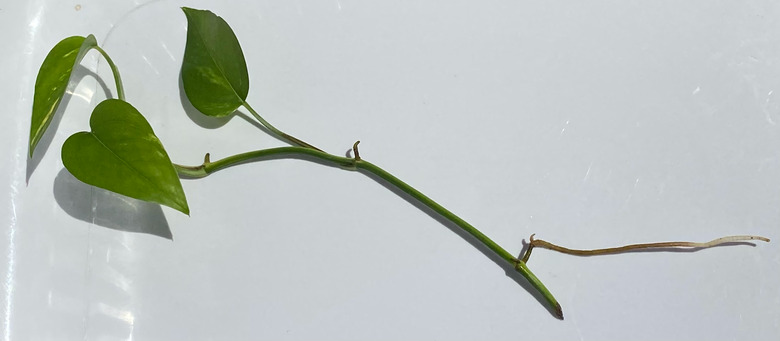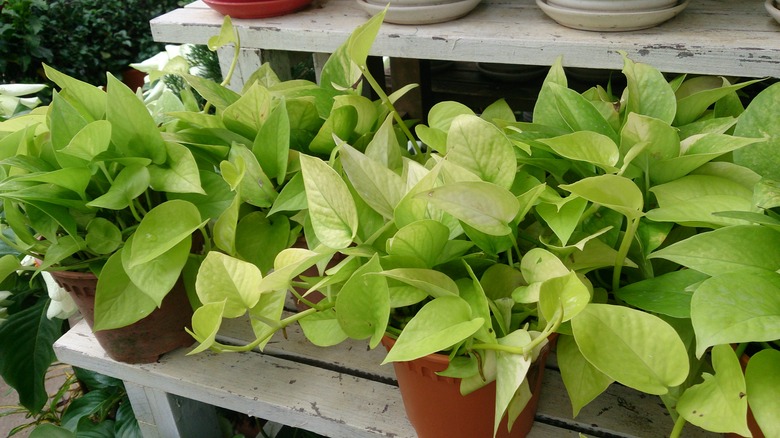How To Propagate A Golden Pothos
Golden pothos (Epipremnum aureum, USDA plant hardiness zones 10 to 12) is an enduring favorite among houseplant gardeners because of its low-maintenance needs and quick growth. It's the perfect houseplant even for beginners because it's nearly impossible to kill, giving rise to one of its common names: devil's ivy.
Although it's not a true ivy species in the genus Hedera, golden pothos vines have long stems that trail or climb like ivies. Pothos vines are adapted to climb because of aerial roots that cling to structures. The long stems, which potentially reach 40 feet long, are so easy to propagate that even beginning gardeners can master this task.
The two most common ways to propagate golden pothos are rooting stem sections in water or soil.
What Is Pothos Propagation?
Plant propagation is the process by which new plants are created from their parent plants. This occurs in nature without human intervention, or it may intentionally happen through human manipulation.
Plant propagation is by sexual reproduction (seeds or spores) or asexual reproduction of vegetative plant parts, including stems, leaves, and roots. However, not all propagation methods apply to all plants, so the key to propagating a specific plant successfully is knowing which method or methods work for that plant.
To propagate pothos plants, you can make new plants simply by rooting stem cuttings.
How to Propagate Pothos in Water
Perhaps the best way to propagate pothos—and certainly the easiest propagation method—is by rooting stem cuttings in water.
To root a new plant, snip stem sections from the mother plant with sharp scissors or pruning shears or by pinching them with your fingers. Remove the leaves from the bottom two leaf nodes, which may look like small brown bumps on the stem.
Place the cutting into a water-filled container, making sure to insert the leafless end into the water. Choose an area that receives indirect light to keep your cuttings. By using the water propagation method, you'll be able to observe root growth if you use a clear glass container to hold the water and cuttings.
It's important to keep any container, but especially one made of clear glass, out of direct sunlight. If the water becomes cloudy, replace it with fresh water and make sure the water level stays above the leafless nodes but below the remaining leaves on the stem.
When the roots are 2 to 3 inches long and you see some new growth at the tip of the stem, it's time to remove your rooted cuttings from the water and plant them into a pot filled with potting mix.
Tip
When rooting pothos cuttings, it's important to keep any container, but especially one made of clear glass, out of direct sunlight. If the water becomes cloudy, replace it with fresh water and make sure the water level stays above the leafless nodes but below the remaining leaves on the stem.
How to Propagate Pothos in Potting Mix
To use the soil propagation method, take pothos cuttings from the parent plant the same way as described above for the water propagation method. Instead of placing cuttings in water, gently press them into a soilless potting mix or use a pencil to poke a hole in the mix.
A potting soil that's formulated for succulents or one that contains perlite is another option for rooting pothos cuttings. Although you can dip the cut end into rooting hormone, pothos vines root so easily that you can skip this step.
Keep the soil moist without ever drying out and use a container that has drainage holes. Keep the container in a bright spot but out of direct sunlight.
Unlike the water propagation method, rooting pothos cuttings in potting mix keeps the root end of the stem out of sight so you won't be able to watch new roots when they form. When you see new leaves forming at the tip of the stem and the stem doesn't yield to a gentle tug, you'll know your cutting has rooted.
Plant Care for Established Pothos Vines
Your new pothos plant will grow best when you keep the potting medium lightly moist but never soggy, as too much moisture may cause root rot. Use a houseplant fertilizer only every other month during the growing season.
Place the pot or hanging basket where it receives bright, indirect light and out of direct sunlight, which can burn the leaves. Although pothos vines will grow in an area that receives low light, they prosper when they receive some indirect sunlight. And when the vines grow long, you'll be able to trim them and propagate more pothos plants to share with family and friends.


